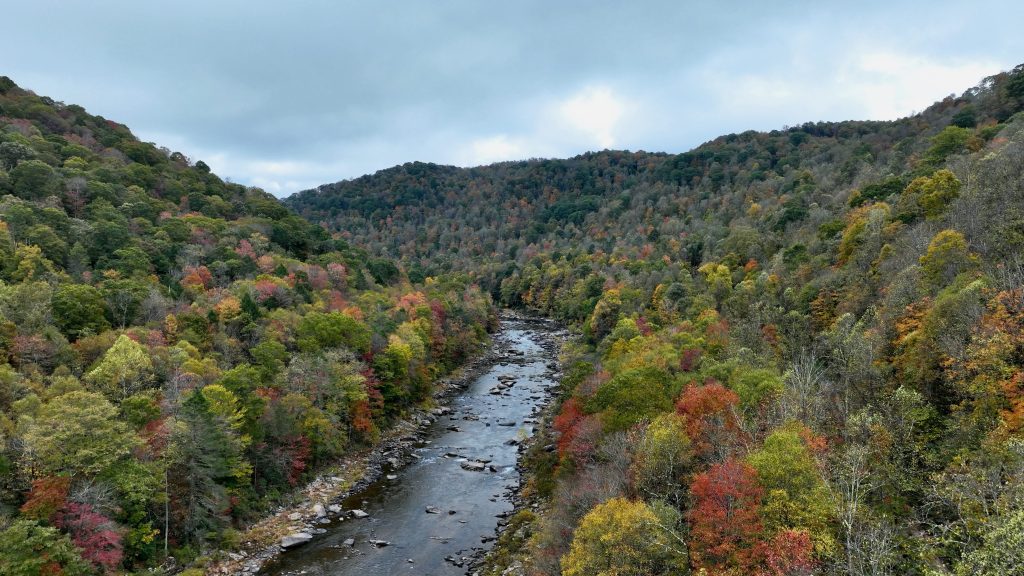On the Road to Recovery: Rebuilding the Virginia Creeper Trail

Hurricane Helene devastated numerous beloved public lands and recreational areas in Central Appalachia, including the popular Virginia Creeper Trail. Despite promising recent updates, the timeline for major restoration and eventual completion for portions of the picturesque rail-to-trail path remains uncertain, requiring small businesses that rely on visitors to pivot or risk closure.
Of the 34-mile multi-use trail stretching from Abingdon to Whitetop Station, Virginia, the upper 18-mile portion from Damascus to Whitetop in the Mount Rogers National Recreation Area is closed until further notice. This stretch drops 1600 feet in elevation on its way down the mountain, and is popular with bicyclists — several businesses in town offer bike rentals and shuttles to the top, and many other businesses cater to the throngs of riders who visit from spring to fall.
Out of the trail’s 47 iconic railway trestles, 31 were severely damaged or destroyed. The U.S Forest Service owns and manages this part of the trail. In addition to the devastation on the trail itself, a 1.5-mile portion of Route 58 between Damascus and Konnarock was destroyed, preventing rebuilding crews from accessing parts of the trail.
“Everything above Taylors Valley, as far as the trail is concerned, has been cut off since September 27,” says Lisa Quigley, executive director of the Virginia Creeper Trail Conservancy. “When you’re on the Creeper Trail above Taylor Valley, you are in a forest, and it’s truly almost impossible to get to some sections of it any other way but being on the trail.”
One small business directly impacted by this closure is Green Cove Collective, a family-run lifestyle outdoor store located along the now-closed section of the trail in Green Cove, about four miles down from Whitetop Station, and a short drive from Damascus via a one-lane dirt road or Route 58. Prior to Hurricane Helene, bikers would park their bikes and walk across a small bridge to the shop, where they could grab a snack or have a cup of coffee and warm up by the woodstove if the weather was chilly.
“The majority of our customer base is people coming down the trail on their bikes,” says Alison Little, co-owner with her husband Scott.
![Rebuilding the Virginia Creeper Trail is uncertain. “[There are] still a lot of individuals who need support, especially here in Green Cove, Whitetop, Konnarock — those are the communities up on the mountain,” says Little. “We were a part of Damascus, but because we are on the mountain outside of Damascus, a lot of the resources and help have not made their way here.” Photo by Jimmy Davidson.](https://appvoices.org/wp-content/uploads/2025/07/Virginia_Creeper_Trail_JMDavidson-32-1024x768.jpg)
The store and bridge sustained flood damage, but thanks to the goodwill of friends and strangers, both are now operational. Yet, as Little explains, “without the trail, we have no customer base.” After months of lost income, Green Cove Collective relocated and reopened in downtown Damascus in April.
“We like being in town for a lot of reasons, but it’s a different crowd,” says Little, sharing how the store is a “different experience” than before, where thousands of bikers each season would stop in on their journey down from Whitetop Station to Damascus or Abingdon.
Thankfully, there have been recent developments regarding the trail. On May 22, Virginia Gov. Glenn Youngkin announced that the Virginia Department of Transportation had restored this section of Route 58 several months ahead of the initially anticipated schedule — a key step in gaining access to more remote parts of the trail.
According to a Forest Service release, this update enables “much needed access to Virginia Creeper Trail trestle and bridge sites for future debris removal and rebuilding efforts, which are currently in the contracting process.” On June 10, the agency announced it had begun initial debris removal, which should take until the end of July.
“We’re really excited that the debris removal has started,” says Little, who lives by the trail and has seen the debris removal work in Taylors Valley. “For all these months, it’s been so quiet and nobody’s here. And we can see damage from our door, and the trail — there’s grass growing on the trail, and it’s getting overgrown — it looks very different than when people were riding on it. And so after all these months of looking at the damage, to know that the work has begun, is very exciting.”
Although the Forest Service has not announced a timeline for trail restoration, the agency released its call for proposals to contractors and engineers for the project. According to the request for proposals, the design and construction cost is estimated to be between $200 million and $300 million.
“The good news is there’s movement — and we’re moving forward,” Quigley says. “That’s a huge relief for everyone.”
In the meantime, enthusiasts can visit and enjoy the lower stretch of the trail, or the “Start to the Heart” from Abingdon to Damascus, which reopened quickly following the storm.
“It’s a beautiful section of the trail,” Quigley says. “Now, it’s not the same as coming from Whitetop to Damascus. Nobody should think it is. But that doesn’t mean it doesn’t come with its own unique qualities. We’re excited to see people take advantage of those.”
While still early in the season, Quigley has seen building excitement for getting back out on the trail, even if it means approaching the ride differently than in years past.
“It’s so easy to have disaster fatigue at this point,” Quigley says. “It can be really detrimental if we allow it to turn into fatigue in general because there are so many small rural communities that rely on this trail, beyond the larger region, for economic reasons. We want to do what we can to support the economies and, ultimately, get the trail back and running.”
How can people best support Green Cove Collective and the surrounding community? Little explains that it’s as simple as spending money.
“If people love these businesses and want to see them survive, they have to support them financially,” she says.
Looking to stay up-to-date with the latest on the trail’s recovery? Visit this new website from the Virginia Creeper Trail Conservancy: https://recovery.vacreepertrail.org/.

Related Articles
Latest News

Leave a comment
Your email address will not be published. Required fields are marked *





Leave a Comment